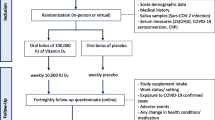Abstract
Successful therapy with vitamin K antagonists requires maintaining a patient in the therapeutic international normalized ratio (INR) range for the particular indication under treatment. Achieving this is dependent on the model of dose management under which the therapy is provided. Most patients in the United States are managed by their individual physician and the time in therapeutic range (TTR) is often low. Patients who have monitored their therapy at home with a point-of-care INR monitor have demonstrated an ability to achieve a high rate of TTR as documented in clinical trials. Recently, similar or even better rates of TTR have been demonstrated in patients performing home monitoring outside of a clinical trial. These findings support the recommendations to implement home monitoring in those who have demonstrated competency in self-management strategies.
Similar content being viewed by others
References
Phillips K, Ansell J (2008) The outpatient management of oral vitamin K antagonist therapy: defining and measuring high quality management. Exp Rev Cardiovas Therap 6:57–70
Ansell J, Hirsh J, Hylek E, Jacobson A, Crowther M, Palareti G (2008) The pharmacology and management of the vitamin K antagonists: ACCP evidence-based clinical practice guidelines. Chest 133:160S–198S
Veeger NJGM, Piersma-Wichers M, Tijssen JGP, Hillege HL, van der Meer J (2005) Individual time within target range in patients treated with vitamin K antagonists: main determinant of quality of anticoagulation and predictor of clinical outcome. A retrospective study of 2,300 consecutive patients with venous thromboembolism. Brit J Haematol 128:513–519
Wan Y, Heneghan C, Perera R, Roberts N, Hollowell J, Glasziou P, Bankhead C, Xu Y (2008) Anticoagulation control and prediction of adverse events in patients with atrial fibrillation: a systematic review. Circ Cardiovasc Qual Outcomes 1:84–91
Connolly SJ, Pogue J, Eikelboom J, Flaker G, Commerford P, Franzosi MG, Healey JS, Yusuf S (2008) Benefit of oral anticoagulant over antiplatelet therapy in atrial fibrillation depends on the quality of international normalized ratio control achieved by centers and countries as measured by time in therapeutic range. Circulation 118:2029–2037
SPORTIF II Investigators (2003) Stroke prevention with the oral direct thrombin inhibitor ximelagatran compared with warfarin in patients with non-valvular atrial fibrillation (SPORTIF III): randomized controlled trial. Lancet 362:1691–1698
SPORTIF V Investigators (2005) Ximelagatran vs warfarin for stroke prevention in patients with nonvalvular atrial fibrillation: a randomized trial. JAMA 293:690–698
EINSTEIN Investigators (2010) Oral rivaroxaban for symptomatic venous thromboembolism. N Engl J Med 363:2499–2510
EINSTEIN-PE Investigators (366) Oral rivaroxaban for the treatment of symptomatic pulmonary embolism. N Engl J Med 366:1287–1297
Ansell JE, Hughes R (1996) Evolving models of warfarin management: anticoagulation clinics, patient self-monitoring, and patient self-management. Am Heart J 132:1095–1100
Ansell JE (1998) Anticoagulation management clinics for the out-patient control of oral anticoagulants. Curr Opin Pulm Med 4:215–219
Ansell JE (2003) Optimizing the efficacy and safety of oral anticoagulant therapy: high quality dose management, anticoagulation clinics, and patient self-management. Semin Vas Med 3:261–269
Matchar DB, Jacobson A, Dolor R, Edson R, Uyeda L, Phibbs CS, Vertrees JE, Shih MC, Holodniy M, Lavori P, and the THINRS Executive Committee (2010) Effect of home testing of international normalized ratio on clinical events. N Eng J Med 363:1608–1620
Lane DA, Boos CH, Lip GYH (2006) Anticoagulation control with vitamin K antagonists: how well are we doing? Chest 129:1122–1124
Baker WL, Cios DA, Sander SD, Coleman CI (2009) Meta-analysis to assess the quality of warfarin control in atrial fibrillation patients in the United States. J Manag Care Pharm 15:244–252
Bloomfield HE, Krause A, Greer N, Taylor BC, MacDonald R, Rutks I, Reddy P, Wilt TJ (2011) Meta-analysis: effect of patient self-testing and self-management of long-term anticoagulation on major clinical outcomes. Ann Intern Med 154:472–482
Heneghan C, Ward A, Perera R (2012) And the self-monitoring trialist collaboration. self-monitoring or oral anticoagulation: systematic review and meta-analysis of individual patient data. Lancet 379:322–334
DeSantis G, Hogan-Schlientz J, Liska G, Kipp S, Sallee R, Wurster M, Ansell J (2012) Real-world warfarin patients achieve and maintain high time in target range, showing suitability for patient self-testing across all age groups. Amer J Hematol 87(suppl):S149
Holbrook A, Schulman S, Witt DM, Vandvik PO, Fish J, Kovacs MJ, Svensson PJ, Veenstra DL, Crowther M, Guyatt GH (2012) Evidence-based management of anticoagulant therapy. Chest 141(suppl):e152S–e184S
Author information
Authors and Affiliations
Corresponding author
Rights and permissions
About this article
Cite this article
Ansell, J. Point-of-care patient self-monitoring of oral vitamin K antagonist therapy. J Thromb Thrombolysis 35, 339–341 (2013). https://doi.org/10.1007/s11239-013-0878-z
Published:
Issue Date:
DOI: https://doi.org/10.1007/s11239-013-0878-z




